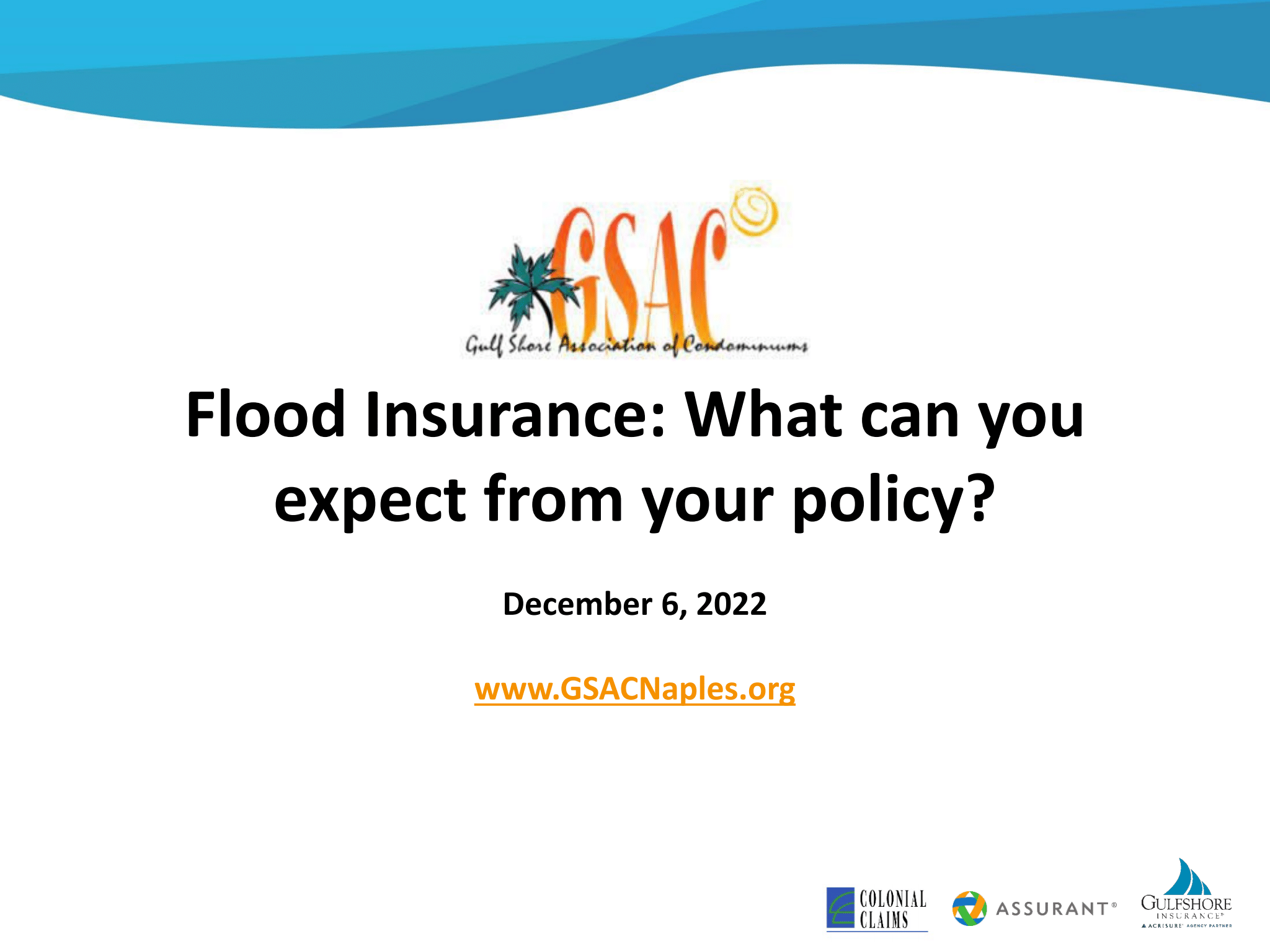By Pamela Nicholls, GSAC Board Member
Submit questions or feedback online
Over 200 residents and members of the Gulf Shore Association of Condominiums Zoomed in to the forum “Flood Insurance: What You Can Expect from your Policy” hosted by GSAC on December 6. Speakers were Joe Thompson from Gulfshore Insurance, Doug Branham, CEO of Colonial Claims Adjusters and Miguel Perez, Flood Claims Manager at Assurant.
Topics covered included FEMA’s National Flood Insurance Program (NFIP), the Flood Insurance Rate Map (FIRM), Residential Condominium Building Association Policy (RCBAP) and the intricacies of the Claims Process.
In his opening remarks, GSAC president Dave Feight told the audience that the objective of the Forum was to inform and not advise. He said the catalyst for the meeting was the post-Ian GSAC survey which highlighted that insurance coverage and the claims process were pressing issues for members.
Gulfshore’s Joe Thompson led off with an overview of the Federal Emergency Management Agency (FEMA) which governs the National Flood Insurance Program. The boilerplate FEMA policy (RCBAP) which provides flood coverage to condominium owners when a state of emergency is declared, does not vary by carrier or from one state or property to the next. The program is federally funded and thus highly regulated.
One of the most salient components of the discussion centered on the Flood Insurance Rate Map and its application to condominium buildings in southwest Florida. Determining your building’s designation as pre-FIRM or post-FIRM, is very important as it will affect the level of coverage for vital assets, including elevators. Buildings which date prior to December 31, 1974 are considered pre-FIRM by FEMA and coverage is far more extensive than for post-FIRM buildings.
Thompson also noted that while private excess flood insurance was extremely cost-prohibitive, it did bridge a gap and older buildings might benefit. “It’s certainly worth a discussion based off the variables of your building,” he said. Self-insuring is another mitigation strategy Thompson suggested condo associations should consider. “Knowing as we do that landscaping and pools and similar physical assets are not insured in the event of flooding, having reserve funding in place to cover losses would be a sensible precaution.”
Doug Branham clarified the role of FEMA-certified independent adjusters. According to Branham, adjusters are assigned by the insurance carrier administering the FEMA policy to do the field work and “scope the loss.”
He also walked participants through contents loss and claims handling. He suggested condominiums should insure at the NFIP’s maximum permitted level of $250,000 a unit and noted that declaring Proof of Loss is not finite. “You can always come back later if costs rise down the line.”
As Miguel Perez explained, the independent adjuster works together with the insurance company’s in-house examiner to ensure FEMA guidelines are followed, estimates are correct and payments for all covered damages are made.
“Our job is to pay you what you are owed, we don’t have the authority to pay any more or any less.”
According to Perez, carriers had received over 46,000 Ian-related claims since the hurricane hit on September 28. Over 30% of those claims had already been finalized.
| Joe Thompson | Doug Branham | Miguel Perez |
|---|---|---|
 |
 |
 |
|
“Flood surge was an out of sight, out of mind peril up until Ian.” |
“The biggest mistake people make is believing they aren’t in a flood zone. Everyone is in a flood zone.” |
“Our job is to pay you what you are owed. We don’t have the authority to pay you any more or any less.” |







